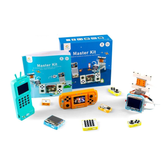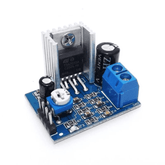-
PAM8403 Digital Power AmplifierPAM8403 Digital Power Amplifier The PAM8403 5V Two-channel Stereo is a 3W+3W, class-D audio amplifier, allowing it to achieve high-quality sound reproduction. The new filterless architecture allows the device to drive the speaker directly, requiring no low-pass output filters, thus saving system cost and PCB...
- Rs. 19
Rs. 34- Rs. 19
- Unit price
- per
Save Rs. 15 -
3 Channel Digital Subwoofer Amplifier Board3 Channel Digital Subwoofer Amplifier Board The 3 channel digital subwoofer amplifier board runs on two high-quality TPA3116D2 digital amplifier chips. It is powered at a DC supply voltage of 12-24V. The subwoofer amplifier board has very sound quality with great amplifying power. This amplifier board has 3...
- Rs. 743
Rs. 1,324- Rs. 743
- Unit price
- per
Save Rs. 581 -
PAM 8403 Amplifier Module with KnobPAM 8403 Amplifier Module with Knob PAM8403 is a basic 5V input amplifier board that can drive two 3W + 3W stereo speakers. It’s a great option for anyone looking for a Class-D stereo audio amplifier with a tiny footprint. The user can get...
- Rs. 62
Rs. 79- Rs. 62
- Unit price
- per
Save Rs. 17 -
TDA 2030A Audio power Amplifier ModuleTDA 2030A Audio power Amplifier Module Want to increase the audio output capability of your project? Well, then this is the perfect module for you. This module is based on the famous TDA2030A Audio Amplifier Module which is capable of 18-watt power output with...
- Rs. 66
Rs. 96- Rs. 66
- Unit price
- per
Save Rs. 30 -
TPA3118 PBTL Mono Digital AmplifierTPA3118 PBTL Mono Digital Amplifier TPA3118 is an audio power amplifier board that enhances low-power, electronic audio signals, such as those from radio receivers or electric guitar pickups or headphones. The power amplifier allows the listener to hear the audio with higher volume and...
- Rs. 119
Rs. 199- Rs. 119
- Unit price
- per
Save Rs. 80 -
PAM8610 Digital Amplifier BoardPAM8610 Digital Amplifier Board This amplifier plate adopts the official standard circuit design. Chip selection used is the United States' imported Long Ding micro class D power amplifier chip. The PAM 8610 is a 15W (per channel) stereo Class-D audio amplifier with DC Volume...
- Rs. 99
Rs. 169- Rs. 99
- Unit price
- per
Save Rs. 70 -
5V DC Mini Class D Pam8403 USB Power Amplifier Board5V DC Mini Class D Pam8403 USB Power Amplifier Board The PAM8403 is a 3W, class-D audio amplifier. It offers low THD+N, allowing it to achieve high-quality sound reproduction. The new filterless architecture allows the device to drive the speaker directly, requiring no low-pass...
- Rs. 43
Rs. 59- Rs. 43
- Unit price
- per
Save Rs. 16 -
NE555 Multi-Channel Waveform Generator ModuleNE555 Multi-Channel Waveform Generator Module NE555 multi-channel waveform generator can generate a square wave, sawtooth wave, triangle wave, sine wave. A waveform output is selected by a jumper, and the circuit is simple and convenient to operate.
- Rs. 465
Rs. 568- Rs. 465
- Unit price
- per
Save Rs. 103 -
7Semi MAX31855 K-Type Thermocouple Amplifier Breakout7Semi MAX31855 K-Type Thermocouple Amplifier Breakout The 7Semi MAX31855 Thermocouple Amplifier Breakout is designed for creators, engineers, and industrial users who need reliable and highly accurate temperature readings from extreme environments. With its advanced MAX31855 converter IC, this breakout allows effortless digital temperature measurement...
- Rs. 546
Rs. 899- Rs. 546
- Unit price
- per
Save Rs. 353 -
XH-M120 PAM8610 Amplifier BoardXH-M120 PAM8610 Amplifier Board The PAM8610 amplifier board is an all-new efficient amplifier board equipped with a 15W dual channel class D audio amplifier. This XH-M120 PAM8610 amplifier board is much more efficient and performs better than the Class AB amplifier boards. This Pam8610...
- Rs. 172
Rs. 339- Rs. 172
- Unit price
- per
Save Rs. 167 -
DTMF Decoder - GLDTMF Decoder - GL Decodes DTMF audio signal to 4 bit binary TTL level output with LED indication. It also indicates outputs with LED. Can be used directly with microcontrollers to develop various DTMF related applications like remote monitoring, remote control, Caller ID, Auto...
- Rs. 175
Rs. 215- Rs. 175
- Unit price
- per
Save Rs. 40 -
7Semi MAX31856 Universal Thermocouple Amplifier Breakout7Semi MAX31856 Universal Thermocouple Amplifier Breakout (ES-12229) The 7Semi MAX31856 Universal Thermocouple Amplifier Breakout is a versatile temperature sensing board designed to work with a wide range of thermocouple types. It allows you to measure temperatures accurately, from very low to extremely high ranges,...
- Rs. 895
Rs. 1,145- Rs. 895
- Unit price
- per
Save Rs. 250
for additional 5% discount! + Redeem RC COINS 👇







































